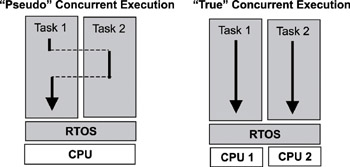Книга: Real-Time Concepts for Embedded Systems
14.3.2 Pseudo versus True Concurrent Execution
14.3.2 Pseudo versus True Concurrent Execution
Concurrent tasks in a real-time application can be scheduled to run on a single processor or multiple processors. Single-processor systems can achieve pseudo concurrent execution, in which an application is decomposed into multiple tasks maximizing the use of a single CPU. It is important to note that on a single-CPU system, only one program counter (also called an instruction pointer) is used, and, hence, only one instruction can be executed at any time. Most applications in this environment use an underlying scheduler's multitasking capabilities to interleave the execution of multiple tasks; therefore, the term pseudo concurrent execution is used.
In contrast, true concurrent execution can be achieved when multiple CPUs are used in the designs of real-time embedded systems. For example, if two CPUs are used in a system, two concurrent tasks can execute in parallel at one time, as shown in Figure 14.3. This parallelism is possible because two program counters (one for each CPU) are used, which allows for two different instructions to execute simultaneously.

Figure 14.3: Pseudo and true concurrent (parallel) execution.
In the case of multiple CPU systems, the underlying RTOS typically is distributed, which means that various components, or copies of RTOS components, can execute on different CPUs. On such systems, multiple tasks can be assigned to run on each CPU, just as they do on single-CPU systems. In this case, even though two or more CPUs allow true concurrent execution, each CPU might actually be executing in a pseudo-concurrent fashion.
Unless explicitly stated, this book refers to both pseudo and true parallel execution as concurrent execution for the sake of simplicity.
Following the outside-in approach, certain types of tasks can be identified near the application edge (i.e., where an application needs to create an interface with an I/O device), whereas other tasks can be internal to the application. From the mobile handheld example, if a design team were to further decompose the application, these internal tasks would be identified. Applications, such as calculator or calendar programs, are some examples of internal tasks or groupings of tasks that can exist within the overall handheld mobile application. These internal tasks are decoupled from the I/O devices; they need no device-specific information in order to run
- TrueCrypt
- Работа со шрифтами TrueType и PostScript Type 1
- Virtualization Versus Paravirtualization
- Choosing a Database: MySQL Versus PostgreSQL
- Функции true и false
- 1.3.1. Free Versus Freedom
- 2.1.1. BIOS Versus Bootloader
- 2.3.6. Execution Contexts
- 7.2.2. Flash Versus RAM
- 7.2.4. Execution Context
- 9.8. Pseudo File Systems
- Using a Pseudorandom Number Generator




